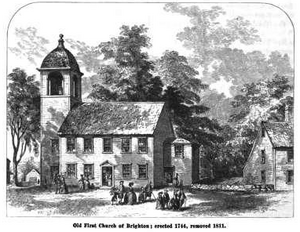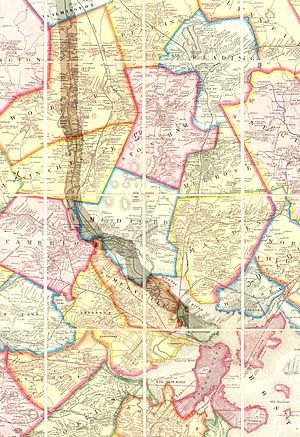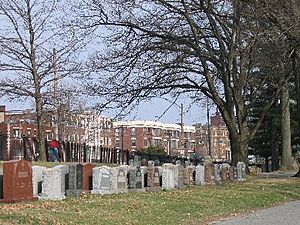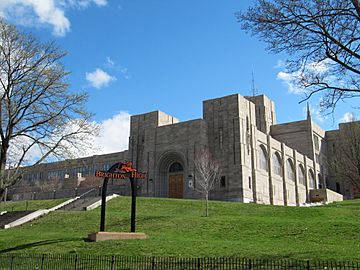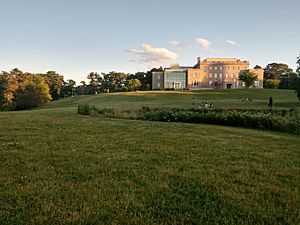Brighton, Boston facts for kids
Quick facts for kids
Brighton
|
||
|---|---|---|
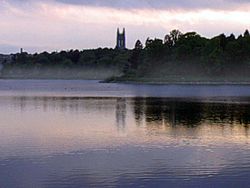
The Chestnut Hill Reservoir is located in the Brighton neighborhood. (Boston College can be seen in the background).
|
||
|
||
| Nicknames:
Little Cambridge, South Cambridge, Third Parish (all archaic)
|
||
| Country | United States | |
| State | Massachusetts | |
| County | Suffolk | |
| Neighborhood of | Boston | |
| Settled | 1630 | |
| Incorporated | February 24, 1807 | |
| Annexed by Boston | January 5, 1874 | |
| Area | ||
| • Land | 2.78 sq mi (7.2 km2) | |
| Population | ||
| • Total | 43,880 | |
| • Density | 15,784/sq mi (6,095/km2) | |
| Time zone | Eastern | |
| • Summer (DST) | Eastern | |
| Zip Code |
02135
|
|
| Area code(s) | 617 / 857 | |
Brighton is a former town and current neighborhood of Boston, Massachusetts, United States, located in the northwestern corner of the city. It is named after the English city of Brighton. Initially Brighton was part of Cambridge, and known as "Little Cambridge". Brighton separated from Cambridge in 1807 after a bridge dispute, and was annexed to Boston in 1874. For much of its early history, it was a rural town with a significant commercial center at its eastern end.
The neighborhood of Allston was also formerly part of the town of Brighton, but is now often considered to be separate, leading to the name Allston–Brighton for the combined area. This historic center of Brighton is the Brighton Center Historic District. The Aberdeen section of Brighton was designated as a local architectural conservation district by the Boston Landmarks Commission in 2001.
Contents
History
In 1630, land comprising present-day Allston–Brighton and Newton was assigned to Watertown. In 1634, the Massachusetts Bay Colony transferred ownership of the south side of the Charles River, including present-day Allston–Brighton and Newton, from Watertown to Newtowne, which was soon renamed Cambridge. In 1646, Reverend John Eliot established a "Praying Indian" village on the present Newton–Brighton boundary, where resided local natives converted to Christianity. The first permanent English settlement came as settlers crossed the Charles River from Cambridge, establishing Little Cambridge, the area's name before 1807.
Before the American Revolutionary War, Little Cambridge became a small, prosperous farming community with fewer than 300 residents. Its inhabitants included wealthy Boston merchants such as Benjamin Faneuil (after whom a street in Brighton is named). A key event in the history of Allston–Brighton was the establishment in 1775 of a cattle market to supply the Continental Army. Jonathan Winship I and Jonathan Winship II established the market, and in the post-war period that followed, the Winships became the largest meat packers in Massachusetts. The residents of Little Cambridge resolved to secede from Cambridge when the latter's government made decisions detrimental to the cattle industry and also failed to repair the Great Bridge linking Little Cambridge with Cambridge proper. Legislative approval for separation was obtained in 1807, and Little Cambridge renamed itself Brighton.
In 1820, the horticulture industry was introduced to the town. Over the next 20 years, Brighton blossomed as one of the most important gardening neighborhoods in the Boston area. Its businessmen did not neglect the cattle industry, however. In 1834, the Boston & Worcester Railroad was built, solidifying the community's hold on the cattle trade. By 1866, the town contained 41 slaughterhouses, which later were consolidated into the Brighton Stock Yards and Brighton Abattoir.
In October 1873, the Town of Brighton in Middlesex County voted to annex itself to the City of Boston in Suffolk County, and in January 1874 Brighton officially became part of the City of Boston. Allston–Brighton's population grew rapidly in the next 50 years, rising from 6,000 in 1875 to 47,000 by 1925.
Transportation
Brighton is accessible via the B branch of the Massachusetts Bay Transportation Authority (MBTA)'s Green Line light rail service, which has 11 stops along Commonwealth Avenue in Brighton, terminating at the Boston College stop at the western edge of Brighton. Cleveland Circle on the C branch is located in the southern tip of Brighton, and Reservoir station on the D branch is located one block to the south. The former A branch of the Green Line, (discontinued in 1969), also served the community. Brighton is also served by MBTA bus routes 57, 57A, 64, 65, 66, 70, 86, 501, and 503, as well as Boston Landing station on the MBTA Commuter Rail Framingham/Worcester Line.
Geography
Brighton is connected to the rest of Boston by the Allston neighborhood. It is otherwise surrounded by Cambridge, Watertown, Newton, and Brookline. The Charles River separates Brighton from Cambridge and Watertown. According to the Census Bureau, Brighton, defined by zip code 02135, has a population of 43,887 and a land area of 2.78 square miles (7.2 km2).
Brighton is administered jointly with the adjacent neighborhood of Allston (zip code 02134). The two are referred to together as "Allston–Brighton " (and by some as "Brighton–Allston"), and (also according to Census Bureau data) have a combined population of 65,276 and a land area of 4.12 square miles (10.7 km2). Brighton is generally to the west of Everett, Gordon and Kelton streets. As of 2020[update], the city councilor of Allston-Brighton is Liz Breadon. Breadon's predecessor Mark Ciommo held this position from 2007 to 2019.
Demographics
As of 2020, the estimated population of Brighton is 48,330. The population density is 15,784 per mi2, slightly lower than the citywide average of 16,686 per mi2. The median age is 29.3. The largest measured age cohort is 25–34, which comprises 36.4% of the population (note: depending on methodology, college students might not be counted). 60.7% of the population have never been married.
The population was 65.5% white, 14.9% Asian American, 4.4% black or African American, and nearly 11.1% Hispanic of any race.
65.5% of Brighton residents graduated from a four-year college.
As of 2020[update], the median home price was $542,900 compared with $291,700 for the country as a whole, and the cost of living was 30% higher than the national average. Brighton has a comparatively older housing stock. The median home age was 67 years and 39.8% of homes were built before 1939.
Race and ancestry
| Race | Percentage of 02135 population |
Percentage of Massachusetts population |
Percentage of United States population |
ZIP Code-to-State Difference |
ZIP Code-to-USA Difference |
|---|---|---|---|---|---|
| White | 72.2% | 81.3% | 76.6% | –9.1% | –4.4% |
| White (Non-Hispanic) | 66.3% | 72.1% | 60.7% | –5.8% | +5.6% |
| Asian | 15.8% | 6.9% | 5.8% | +8.9% | +10.0% |
| Hispanic | 10.2% | 11.9% | 18.1% | –1.7% | –7.9% |
| Black | 5.1% | 8.8% | 13.4% | –3.7% | –8.3% |
| Native Americans/Hawaiians | 0.5% | 0.6% | 1.5% | –0.1% | –1.0% |
| Two or more races | 2.6% | 2.4% | 2.7% | +0.2% | –0.1% |
According to the 2012-2016 American Community Survey 5-Year Estimates, the largest ancestry groups in ZIP Code 02135 are:
| Ancestry | Percentage of 02135 population |
Percentage of Massachusetts population |
Percentage of United States population |
ZIP Code-to-State Difference |
ZIP Code-to-USA Difference |
|---|---|---|---|---|---|
| Irish | 20.35% | 21.16% | 10.39% | –0.80% | +9.97% |
| Italian | 10.96% | 13.19% | 5.39% | –2.23% | +5.57% |
| Chinese | 10.70% | 2.28% | 1.24% | +8.42% | +9.46% |
| English | 7.72% | 9.77% | 7.67% | –2.06% | +0.05% |
| German | 5.82% | 6.00% | 14.40% | –0.19% | –8.59% |
| Russian | 4.37% | 1.65% | 0.88% | +2.72% | +3.49% |
| Polish | 3.96% | 4.67% | 2.93% | –0.71% | +1.03% |
| Puerto Rican | 2.85% | 4.52% | 1.66% | –1.67% | +1.19 |
| American | 2.51% | 4.26% | 6.89% | –1.75% | –4.39% |
| French | 2.37% | 6.82% | 2.56% | –4.45% | –0.19% |
| French Canadian | 1.98% | 3.91% | 0.65% | –1.92% | +1.33% |
| Mexican | 1.79% | 0.67% | 11.96% | +1.12% | –10.17% |
| Sub-Saharan African | 1.66% | 2.00% | 1.01% | –0.34% | +0.64% |
| Scottish | 1.57% | 2.28% | 1.71% | –0.72% | –0.15% |
| Asian Indian | 1.56% | 1.39% | 1.09% | +0.17% | +0.37% |
| Swedish | 1.35% | 1.67% | 1.23% | –0.32% | +0.12% |
| Greek | 1.32% | 1.22% | 0.40% | +0.10% | +0.82% |
| Portuguese | 1.06% | 4.40% | 0.43% | –3.34% | +0.63% |
Education
Brighton is home to many Boston Public Schools:
- Elementary
- Edison School
- Winship School
- Baldwin Pilot School
- Mary Lyon Lower School (K–8)
- Secondary
- Boston Green Academy
- Brighton High School
- Mary Lyon Upper Pilot High School (9–12)
- Saint Joseph Preparatory High School
Brighton was home to many Catholic schools, many of which have closed: Our Lady of the Presentation in Oak Square (closed 2005), Saint Gabriel's, behind Saint Elizabeth Medical Center (closed 1970), Saint Sebastian's School in the Oak Square Heights (moved to Needham in 1977). Our Lady of Presentation School is currently under study for landmark status by the Boston Landmarks Commission. Remaining are Saint Columbkille's School on Arlington Street (K–8) and St. Joseph's Preparatory Academy (formerly Mount St. Joseph Academy), a co-educational high school located on Cambridge Street. The EF International Language School, an English and college preparatory school for international students, is located on Lake Street. The City of Boston leases the former Hamilton Elementary School building on Chestnut Hill Avenue to Bais Yaakov High School for Girls and Torah Academy of Brookline; Shaloh House Hebrew Day School is several blocks away.
Brighton is home to the Everest Institute, Saint John's Seminary and portions of Boston College. The area is also close to other colleges, including Boston University, and houses many of their students and faculty.
Notable people
- Michael Bloomberg, mayor of New York City, born in Brighton, but raised in Medford
- Mike Brady, winner of nine PGA events between 1916 and 1926
- Fred Cusick, Boston Bruins play-by-play announcer for 45 years
- Steve DeOssie, former professional football player for the NFL's New York Giants and New England Patriots
- Dave Fay, sports journalist
- William F. Galvin, Massachusetts Secretary of State
- Beth Howland, actress
- John Kelleher, was a backup infielder in Major League Baseball, playing mainly for Chicago Cubs.
- John F. Kelly, the 5th United States Secretary of Homeland Security
- Joseph P. Kennedy II, son of the late Robert F. Kennedy; former U.S. Congressman for Massachusetts's 8th district
- Patrick J. Kennedy, son of the late Ted Kennedy; former U.S. Congressman for Rhode Island's 1st district
- Chang Sik Kim, South Korean Buddhist master and founder of the art of Shim Gum Do, a Korean sword school
- John Krasinski, film actor, director, writer
- Dennis Lehane, author of Mystic River and many other Boston-set novels
- Mr. Lif, rapper
- Theodore B. Lyman, fourth Bishop of the Episcopal Diocese of North Carolina
- Joe Matson, racing driver
- Mike Milbury, former coach and player of the NHL's Boston Bruins
- Amy Poehler, actress writer and comedian, lived on Strathmore Road while in college
- Brigadier General Edmund Rice, recipient of the Medal of Honor
- Edward E. Rice, New York stage producer.
- Fred Salvucci, former Massachusetts Secretary of Transportation
- Simon Shnapir, American Olympic medalist pair skater
- Charles Richard Stith, former U.S. Ambassador to Tanzania
- Aidan "Eggsy Malone" Thaggard, notorious bank robber and bootlegger during the 1930s
- Noah Welch, professional hockey player, 2018 US Olympic Team Member
See also
 In Spanish: Brighton (Boston) para niños
In Spanish: Brighton (Boston) para niños



